Patbingsu
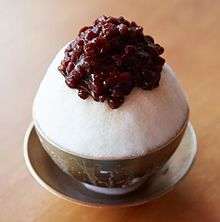 | |
| Alternative names | Bingsu |
|---|---|
| Type | Shaved ice |
| Course | Dessert |
| Place of origin | Korea |
| Serving temperature | Cold |
| Main ingredients | Shaved ice, red beans |
| Variations | Nokcha-bingsu (green tea bingsu), ttalgi-bingsu (strawberry bingsu), choko-bingsu (chocolate bingsu), etc. |
| Korean name | |
| Hangul | 팥빙수 / 빙수 |
|---|---|
| Hanja | -氷水 / 氷水 |
| Revised Romanization | patbingsu / bingsu |
| McCune–Reischauer | p'atpingsu / pingsu |
| IPA | [pʰat̚.p͈iŋ.su] / [piŋ.su] |
Patbingsu (팥빙수, sometimes anglicized as patbingsoo, literally "red beans shaved ice") is a popular Korean shaved ice dessert with sweet toppings that may include chopped fruit, condensed milk, fruit syrup, and red beans.[1] Varieties with ingredients other than red beans are called bingsu[2] (or bingsoo).[3]
The food originally began as ice shavings with red bean paste (known as pat, 팥). Many varieties of patbingsu exist in contemporary culture.
History
The early forms of patbingsu consisted of shaved ice and two or three ingredients, typically red bean paste, tteok, and ground nut powder.[4] The earliest forms of patbingsu existed during the Joseon Dynasty (1392–1910). Government records show officials sharing crushed ice topped with various fruits.[5][6]
The modern forms of patbingsu are reputed to have originated during the period of Korea under Japanese rule (1910–1945) with the introduction of a cold dish featuring red bean paste.[5][6] The combination of red bean paste and shaved ice is a Korean invention.[7] During the Korean War (1950–1953), foreign influence led to the inclusion of ingredients such as fruit cocktail, ice cream,[8] fruits, nuts, cereal, syrups, and whipped cream.[7] In the 1970s and 1980s, popular ingredients included fruit cocktail, whipped cream, and maraschino cherries.[8]
Variations
There are a variety of patbingsu types and flavors. Many bingsus do not necessarily follow tradition, and some do not include the red bean paste.[9] Some popular flavors are: green tea, coffee, and yogurt.[10]
Availability
Patbingsu can be found at most fast food restaurants, cafes, and bakeries in South Korea.[1] Patbingsu is also a very popular dessert at cafes in the Koreatowns of Vancouver, New York City, Los Angeles, and Atlanta.[11]
Gallery
 various bingsu
various bingsu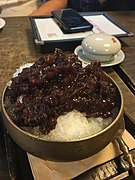 Patbingsu
Patbingsu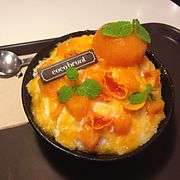 Persimmon bingsu from Coco Bruni patisserie in Hannam-dong, Seoul
Persimmon bingsu from Coco Bruni patisserie in Hannam-dong, Seoul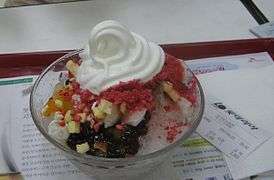 Lotteria offers an elaborate version with ice cream
Lotteria offers an elaborate version with ice cream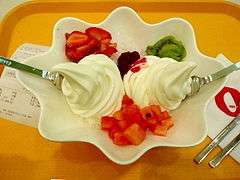 A yogurt bingsu from the popular Korean Red Mango chain
A yogurt bingsu from the popular Korean Red Mango chain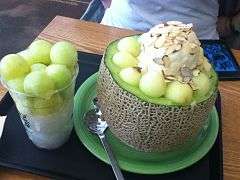 Melon bingsu from 'Chaoruem' near Gangnam station.
Melon bingsu from 'Chaoruem' near Gangnam station.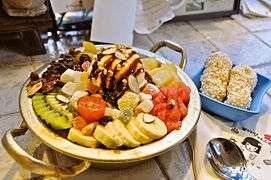 Patbingsu topped with fruits
Patbingsu topped with fruits- bingsu with berries
- Milk tea flavor bing-su
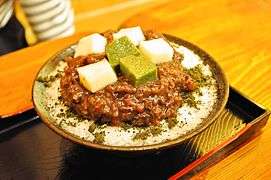 Black sesame bing-su
Black sesame bing-su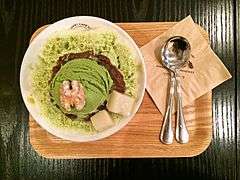 Greentea patbingsu
Greentea patbingsu Green tea bingsu
Green tea bingsu- Cheese bingsu
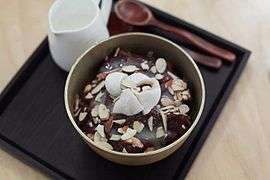 Patbingsu
Patbingsu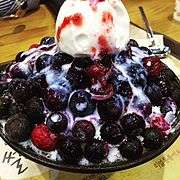 Mixed-berry Bingsu
Mixed-berry Bingsu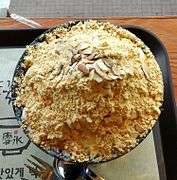
See also
References
- 1 2 Lee, Robyn (June 5, 2009). "Snapshots from South Korea: Patbingsu, a Popular Shaved Ice Dessert". Serious Eats. Retrieved January 5, 2013.
- ↑ CNN, By Kyoung Woo Jun, for. "Seoul hotels at war over dessert - CNN.com". CNN. Retrieved 2016-05-05.
- ↑ Hoo, Winyan Soo (2014-07-16). "Plate Lab: A guide to Asian shaved ice desserts halo-halo, bao-bing and bingsoo". The Washington Post. ISSN 0190-8286. Retrieved 2016-05-05.
- ↑ Min, Ines (June 3, 2010). "Ice cream explorations and a peek into the past". The Korea Times. Retrieved January 5, 2014.
- 1 2 Dang, Tae Keuk (September 13, 2010). "Snowy delights and variations on bingsu". Herald Corporation. Retrieved January 6, 2014.
- 1 2 팥빙수[氷水] [Patbingsu]. Doopedia (in Korean). Doosan Corporation. Retrieved January 6, 2014.
- 1 2 Comeau, Kimberly (September 27, 2011). "Get ready for patbingsu: Red beans over shaved ice". The Jeju Weekly. jeju weekly.com. Retrieved January 6, 2013.
- 1 2 Imatome-Yun, Naomi. "Shaved Ice Dessert with Sweet Beans Recipe (Patbingsu)". About.com. Retrieved January 6, 2013.
- ↑ "Bingsu, an unbeatable summer treat!". KOREA TOURISM ORGANIZATION. Retrieved January 6, 2014.
- ↑ Lee, Ji-yoon (July 7, 2008). "Korea's cold summer taste - naengmyeon and patbingsu". Korea.net. The Korean Culture and Information Service. Retrieved January 6, 2013.
- ↑ Amter, Charlie. "A game of top this in frozen yogurt wars". Los Angeles Times. Archived from the original on April 4, 2009. Retrieved January 6, 2013.
External links
| Wikimedia Commons has media related to Patbingsu. |